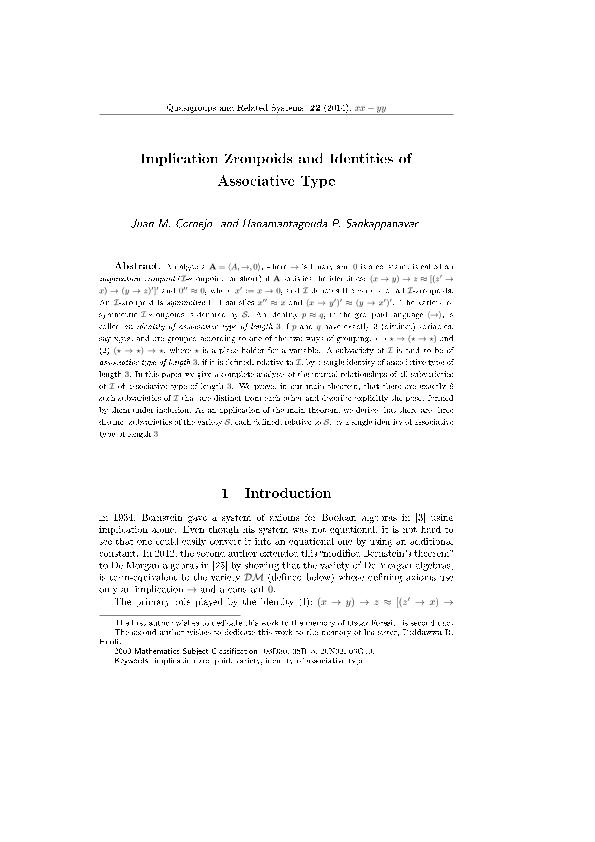Artículo
Implication Zroupoids and Identities of Associative Type
Fecha de publicación:
08/2018
Editorial:
Institute of Mathematics of the Moldovian Academy of Sciences
Revista:
Quasigroups and Related Systems
ISSN:
1561-2848
Idioma:
Inglés
Tipo de recurso:
Artículo publicado
Clasificación temática:
Resumen
An algebra A=⟨A,→,0⟩, where → is binary and 0 is a constant, is called an implication zroupoid (I-zroupoid, for short) if A satisfies the identities: (x→y)→z≈[(z′→x)→(y→z)′]′ and 0′′≈0, where x′:=x→0, and I denotes the variety of all I-zroupoids. An I-zroupoid is symmetric if it satisfies x′′≈x and (x→y′)′≈(y→x′)′. The variety of symmetric I-zroupoids is denoted by S. An identity p≈q, in the groupoid language ⟨→⟩, is called an identity of associative type of length 3 if p and q have exactly 3 (distinct) variables, say x,y,z, and are grouped according to one of the two ways of grouping: (1) ⋆→(⋆→⋆) and (2) (⋆→⋆)→⋆, where ⋆ is a place holder for a variable. A subvariety of I is said to be of associative type of length 3, if it is defined, relative to I, by a single identity of associative type of length 3. In this paper we give a complete analysis of the mutual relationships of all subvarieties of I of associative type of length 3. We prove, in our main theorem, that there are exactly 8 such subvarieties of I that are distinct from each other and describe explicitly the poset formed by them under inclusion. As an application of the main theorem, we derive that there are three distinct subvarieties of the variety S, each defined, relative to S, by a single identity of associative type of length 3.
Palabras clave:
IMPLICATION ZRUPOID
,
VARIETY
,
IDENTITY OF ASSOCIATIVE TYPE
Archivos asociados
Licencia
Identificadores
Colecciones
Articulos(INMABB)
Articulos de INST.DE MATEMATICA BAHIA BLANCA (I)
Articulos de INST.DE MATEMATICA BAHIA BLANCA (I)
Citación
Cornejo, Juan Manuel; Sankappanavar, Hanamantagouda P.; Implication Zroupoids and Identities of Associative Type; Institute of Mathematics of the Moldovian Academy of Sciences; Quasigroups and Related Systems; 26; 1; 8-2018; 13-34
Compartir




